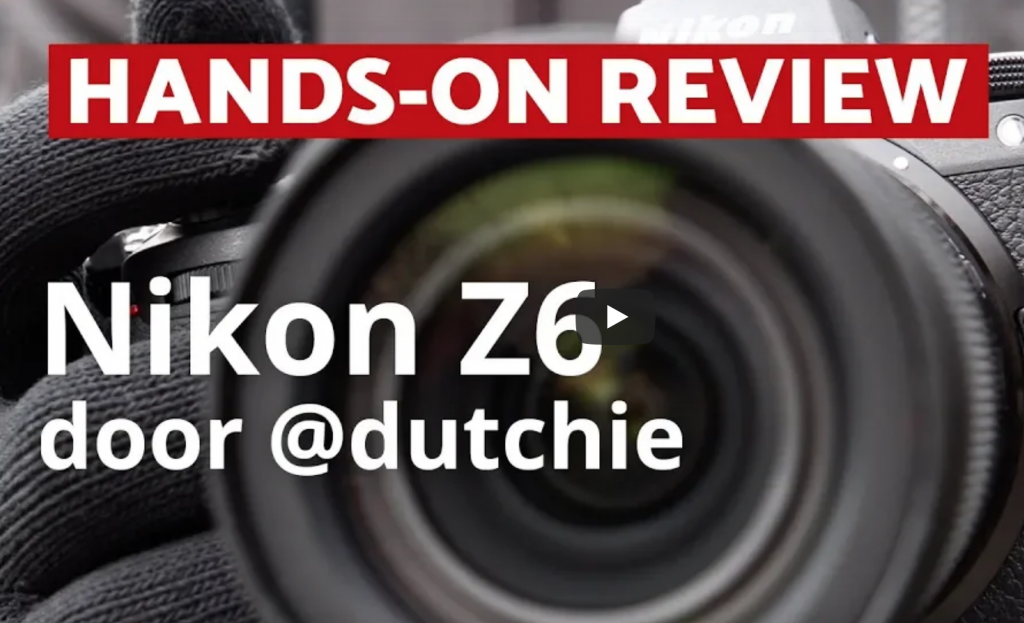Sure, when you release the Z6 and Z7 almost simultaneously, the Z6 is going to be overshadowed a bit by its big brother. Then when you look at the price differences, you might want to think again. The Z6 is so much more affordable and its still a great camera. Nikon managed to do a very solid job with its first set of system cameras.
This camera offers a 24.5 megapixel resolution. This is not quite as many AF points as the Z7, but it has a much lower price. Next to that it offers a wider ISO range, full frame (no crop) 4K video and an even faster 12fps frame rate.
During my try outs of the new Z6 I found the auto focus to be fast and accurate. Additionally having in body stabilisation is a very welcome addition. I often do street photography so it’s always a game of see and react. A scene happens and you need to quickly respond to capture it. Often you only have one try before the moment passes. Due to this i’m not always fully set and steady while shooting. Image stabilisation and a fast auto focus really helps with getting great and sharp images here. The Z6 didn’t disappoint.
One tiny flaw seems to be the buffer in the camera when shooting in burst mode. This camera is fast. It offers up to 12 frames per second in burst mode, which is superb for capturing fast moving objects. The slight limitation here turned to be the in camera buffer, which “only” allows up to about 4 seconds of shooting in burst mode before it fills up.
For those who follow me on Instagram on a daily basis, you know I mainly shoot with my Nikon D850. This is an absolute amazing camera and i’m still not sure any other camera out there is actually better. Working with the Z6 gave me a newer camera, but aimed to be a smaller brother to the Z7. Which again should be equal to the D850. On the other hand, the Z6 does have some features that outperform the way more expensive D850. Overall, if you have the money to go for the absolute best, go grab that D850,
One feature that differentiates the Z6 and the D850 is like mentioned the in-body image stabilization (IBIS). The Z6 reduces the risk of handshake-induced blur with all attached lenses, while the D850 has to rely on optical image stabilization in lenses to achieve the same effect.
Another thing vastly different is that the Z6 writes its imaging data to XQD cards, while the D850 uses SDHC or XQD cards. With XQD being very expensive cards I kind of see this as a disappointment. Why not make it dual slot like the D850 and have the user chose which to use. Only few people actually need the advantages the XQD brings. (like extreme high speed read and writing) The D850 features dual card slots, which can be very useful in case a memory card fails. In contrast, the Z6 only has one slot. So all the memory cards you might have, most likely are SDHC and thus can not be used in the Z6.
A BIG plus for me is the small size of the camera, but also not being extremely small. It feels good when holding it and you do not have the feeling it will slip and fall all the time. A smaller sized camera means less carrying around on a long day of shooting.
When buying the camera it comes with an adaptor that allows you to use all your old Nikon lenses on this camera. Yes, an adaptor is needed because this new Nikon Z mount is bigger than you are used to and non Z series lenses do not fit standardly. Having the adaptor instantly upon buying the camera is ideal as it allows you to use any Nikkor F mount lens on your Z6.
Full AF/AE supported when using FX or DX AF-S Type G/D/E, AF-P type G/E, AF-I type D and AF-S/AF-I Teleconverters. An added benefit of using your older F-mount lenses is the built-in Vibration Reduction image stabilization of the Z series cameras, so lenses without VR now become image stabilized.
There is one limitation with the FTZ adaptor. The Nikon Z6 (and Z7) do not have in-camera AF motors, so if you have older AF lenses without internal drives, these will be manual focus only.
Here’s my pro’s and con’s I experienced from testing the new Z6 camera:
Pro:
12fps burst mode
Superb high-ISO quality
ISO range of 100-51200, making it useful for shooting in low light situations.
In-body stabilisation
Full frame 4K video
Stellar Z-mount lenses
It brings a familiar feel to those already using Nikon DSLRs.
Fantastic handling
Excellent electronic viewfinder
In-body image stabilisation good for handheld shooting
Con:
Weak 310-shot battery life
Average buffer capacity
It only supports XQD cards, which are not really that affordable.
It only has one memory card slot, which can be an inconvenience for some users.
Only three native lenses at launch
Screen only tilts (rather than fully articulates)
I’ll spare you all the technical details, and specs for the camera as you can easily read them on any retailer page. See for example here at CameraNu, which for any Dutchie, should be your go to retailer. Their service is surely the best in the country.
Since I value their service and quality, they value my support and thus asked me to do this Z6 try out for them and they made a product video out of it. You can find this video below or here (it’s in Dutch):
Want to talk about my experiences with this camera a bit more? Just reach out to me. Comment below, or just send me an e-mail or direct message on Instagram. As many of you know, getting me a coffee makes me a very willing to meet and talk kinda person. 😉
Best,
D.




The Silent Shutter Mode (also known as Electronic Shutter ) is only available on the Nikon D850. One must be in Live View mode and set up the camera by pressing the i button, navigating to Silent live view photography , then picking Mode 1 . Once turned on, the camera will not engage its shutter mechanism at all and there won t be a need for either Mirror Up or EFCS, since the mirror is already raised and the shutter mechanism is disabled. When using this feature, it is best to use it in combination with Self-Timer, but one can also use it in combination with EDM timer.